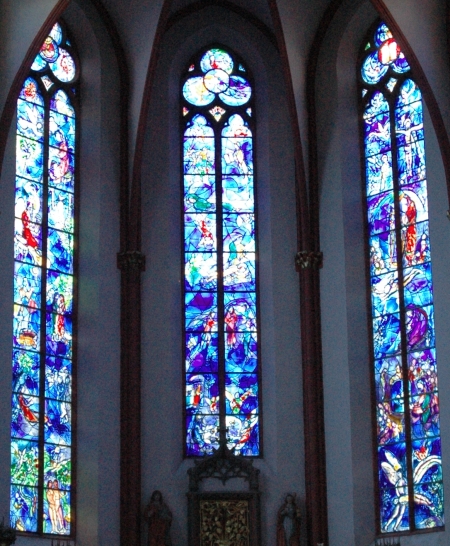« Gunpowder, treason and ..... | Main | Any offers? »
November 06, 2005
The eastern choir of St. Stephan
In 1973 Marc Chagall, "the master of colour and the Biblical message" was approached by the parish priest of St. Stephan requesting him to design stained glass windows for the apse of the church. It cannot have been easy for the Jewish artist to meet such a request from German parish. But finally he accepted and began drawing the first sketches in December 1978.
From the very first the windows were intended to be a visible sign of friendship between France and Germany but also between Jews and Christians. The latter is expressed in the central window of the eastern choir.

Lower half of the window in the middle
The bond between Jews and Christians is the belief they share in one God. Accodingly the following Biblical events were chosen for the central window (from bottom to top):
Abraham being visited by the three angels (Gen. 18,1-10a)
Abraham interceding for Sodom and Gomorrah (Gen. 18,20-33)

Upper half of the same window
Sacrifice of Isaac (Gen. 22,1-18)
Dream of Jacob (Gen. 28,10-17)
Moses giving the Ten Commandments to his people (Exod. 34,27-32)
These illustrations are also symbols of the celebration of the Eucharist. We pay honour to God in three persons as indicated by the three angels. The Eucharistic feast closely related to the feast of Yahweh at Abraham's table, the intercessory prayers being depicted as Abraham's act of intercession. The sacrifice of Christ is implied in the sacrifice of Isaac. Moses represents the preaching of the Word of God and Jacob's dream the mystery of every house of God.

The three central windows of the eastern choir
Compared to the windows on both sides the figures in the central window are rather small. Most of the window is taken up by the blue background. Blue is supposed to inspire tranquillity and encourage meditation. And, indeed, it does have this effect on the visitor. The blue background is also a symbol of the unfathomable God in the windows: we cannot actually see God, but he is always there with us and may reveal himself to us on occasions.
The two windows flanking the centre one depict the story of human salvation beginning with creation in the lowest picture on the right window. Two main motifs can be seen in these two windows. The first is the pledge made by God with the whole of Creation which is expressed by the words spoken to Noah: "I will set my bow in the clouds, and it shall be the sign of a covenant between me and between the earth" (Gen. 9,13). The second one comes as a bit of a surprise subject to be portrayed in a stained church window: the fact that man and woman are shown as equal in rank, virtually a pair, in their role in the history of human salvation. Unfortunately my photographs are not good enough to show you the scenes in the windows in detail. You just have to believe that from what we see in the windows the left one could be called "Window of the woman" and the right one "Window of the man". The artist intended them to carry on a dialogue. It starts with Creation on the lower left (characterised by the rainbow) and moves to the joys of paradise in the lower left. You can probably recognise those two on the photos. And so it goes on.
The windows are absolutely fascinating, even more so the longer you look at them. If you ever have the chance to visit Mainz come and look for yourself!
Posted by Mausi at November 6, 2005 04:38 PM
Trackback Pings
TrackBack URL for this entry:
http://mt3.mu.nu/mt/mt-tb.cgi/3330
Comments
A real example of interfaith reconciliation and co-operation. What a pity we cannot have more of this sort of work between people of different faiths for the Glory of God.
Posted by: The Gray Monk at November 6, 2005 06:30 AM